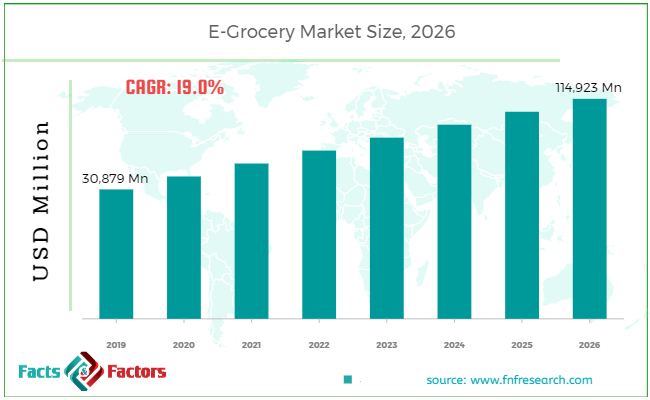Search Market Research Report
E-Grocery Market Size, Share Global Analysis Report, 2020–2026

E-Grocery Market By End Users (Individuals, Organization (Small and Medium Enterprises, and Large Enterprises)); By Type (Indirect, and Direct); By Product Type (Food Grains, Bread, Bakery and Dairy Products, Fruits and Vegetables, Dry and Baking Products, Beverages, and Others); By Business Model (Delivery, and Takeaway); By Platform (Web Based, and App Based); By Purchase Type(One-time Purchase, and Subscription): North America Industry Outlook, Market Size, Business Intelligence, Consumer Preferences, Statistical Surveys, Comprehensive Analysis, Historical Developments, Current Trends, and Forecast 2020–2026
Industry Insights
[220+ Pages Report] According to the report published by Facts Factors, the global e-grocery market size was worth around USD 30,879.1 million in 2019 and is predicted to grow to around USD 114,923.8 million by 2026 with a compound annual growth rate (CAGR) of roughly 19.0% between 2020 and 2026. The report analyzes the global e-grocery market drivers, restraints/challenges, and the effect they have on the demands during the projection period. In addition, the report explores emerging opportunities in the e-grocery market.

This specialized expertise oriented industry research report scrutinizes the technical and commercial business outlook of the e-grocery industry. The report analyzes and declares the historical and current trends analysis of the e-grocery industry and subsequently recommends the projected trends anticipated to be observed in the e-grocery market in the upcoming years.
The e-grocery market report analyzes and notifies the industry statistics at the regional and country levels in order to acquire a thorough perspective of the entire e-grocery market. The historical and past insights are provided for FY 2016 to FY 2019 whereas projected trends are delivered for FY 2020 to FY 2026. The quantitative and numerical data is represented in terms of both volumes (Units) and value (USD Million) from FY 2016 – 2026.
 Key Insights from Primary Research
Key Insights from Primary Research
- As per our primary respondents, the e-Grocery market is set to grow annually at a CAGR rate of 19.0%. In 2019, the market is valued at around USD 30,879 Million and is expected to reach at around USD 114,925 Million by 2026.
- On basis of end-user segment, ‘individual’ segment dominated the e-Grocery market in 2019. The individual segment is expected to be the fastest growing segment over the projected years and estimated to register USD 91,132.4 Million by 2026.
- On basis of type segment, ‘indirect’ type dominated the e-Grocery market in 2019. This segment will grow at a CAGR rate of 20.9% over the forecast period. This segment generated is valued at around USD 16,126.0 Million in 2019 and expected to reach USD 73,814.5 Million by 2026.
- On basis of product type segment, ‘bread, bakery and dairy products’ dominated the e-Grocery market in 2019. This segment will grow at a CAGR rate of 19.1% over the forecast period.
- As per our primary respondents, United States region accounted the highest market share in the e-Grocery market in 2019. This segment generated revenues worth USD 29,402.7 Million in 2019 and expected to reach USD 110,434.9 Million by 2026
 Key Recommendations from Analysts
Key Recommendations from Analysts
- As per our analysts, the e-Grocery market is expected to grow significantly over the forecast period.
- As per analysts, the incorporation of new technologies such as voice enabled technologies in e-grocery is anticipated to accelerate the growth of the market during the forecast period.
- The strategic and competitive advantage provided by digital payment methods is estimated to drive this market.
- As per analysts, growth of e-commerce industry is contributing to the growth of the market.
- Our team of analysts has identified that United States is expected to be the fastest growing country segment over the forecast period owing to its higher internet penetration coupled with growing awareness among the end-users regarding the grocery apps.
The quantitative data is further underlined and reinforced by comprehensive qualitative data which comprises various across-the-board market dynamics. The rationales which directly or indirectly impact the e-grocery industry are exemplified through parameters such as growth drivers, restraints, challenges, and opportunities among other impacting factors.
Throughout our research report, we have encompassed all the proven models and tools of industry analysis and extensively illustrated all the key business strategies and business models adopted in the e-grocery industry. The report provides an all-inclusive and detailed competitive landscape prevalent in the e-grocery market.
The report utilizes established industry analysis tools and models such as Porter’s Five Forces framework to analyze and recognize critical business strategies adopted by various stakeholders involved in the entire value chain of the e-grocery industry. The e-grocery market report additionally employs SWOT analysis and PESTLE analysis models for further in-depth analysis.
The report study further includes an in-depth analysis of industry players' market shares and provides an overview of leading players' market position in the e-grocery sector. Key strategic developments in the e-grocery market competitive landscape such as acquisitions & mergers, inaugurations of different products and services, partnerships & joint ventures, MoU agreements, VC & funding activities, R&D activities, and geographic expansion among other noteworthy activities by key players of the e-grocery market are appropriately highlighted in the report.
Penetration of internet had played a vital role in connecting people in various ways. The internet has greatly helped to shorten the gap between people and their prospects. Additionally, rapid urbanization has elevated the working population. They are more prone towards online grocery shopping due to their hectic schedules. Moreover, traditional grocery requires hours, to pay the bill in counters, while online grocery saves time. Therefore, consumer preference towards e-grocery owing to such factors is increasing the market demand in recent years. Although, online grocery looks promising when compared to other products available online but it faces rather different challenges such as lack of physical evidence and verification of the products. Furthermore, advances in technology and rise in omnichannel marketing and sales is expected to increase the market demand in upcoming years.
The e-grocery market research report delivers an acute valuation and taxonomy of the e-grocery industry by practically splitting the market on the basis of different types, applications, and regions. Through the analysis of the historical and projected trends, all the segments and sub-segments were evaluated through the bottom-up approach, and different market sizes have been projected for FY 2020 to FY 2026.
 Report Scope
Report Scope
Report Attribute |
Details |
Market Size in 2019 |
USD 30,879.1 Million |
Projected Market Size in 2026 |
USD 114,923.8 Million |
CAGR Growth Rate |
19.0% CAGR |
Base Year |
2019 |
Forecast Years |
2020-2026 |
Key Market Players |
7-Eleven, Inc., ALDI, Amazon.com, Inc., Beelivery, Fresh Direct, LLC., Google LLC, Instacart, Postmates Inc., Ahold Delhaize, Albertsons Companies, Target Corporation, Kroger Co., and Walmart among others. |
Key Segment |
By End Users, Type, Product, Business, Platform, Purchase, and Region |
Major Regions Covered |
North America, Europe, Asia Pacific, Latin America, and the Middle East & Africa |
Purchase Options |
Request customized purchase options to meet your research needs.Explore purchase options |
The regional segmentation of the e-grocery industry includes the complete classification of all the major countries including U.S., Canada, and Mexico. E-grocery market has been segmented into end users, type, product type, business model, platform, purchase type, and region. The end users segment has been classified into individuals, and organization. The organization has been categorized into large enterprises, small and medium enterprises in terms of the organization size.
Based on type, the market has been divided into indirect, and direct. Based on product type, the market has been segregated into food grains, bread, bakery and dairy products, fruits and vegetables, dry and baking products, and beverages among others. The business model is of two types that are delivery, and takeaway. On the basis of platform, the market has been segmented into web-based, and app-based. Furthermore, the purchase type has been bifurcated into one-time purchase, and subscription.
 Some of the essential players operating in the e-grocery market, but not restricted to include
Some of the essential players operating in the e-grocery market, but not restricted to include
- 7-Eleven Inc.
- ALDI
- Amazon.com Inc.
- Beelivery
- Fresh Direct LLC.
- Google LLC
- Instacart
- Postmates Inc.
- Ahold Delhaize
- Albertsons Companies
- Target Corporation
- Kroger Co.
This report segments the e-grocery market as follows:
 By End Users Segmentation Analysis
By End Users Segmentation Analysis
- Individuals
- Organization
- Small and Medium Enterprises
- Large Enterprises
 By Type Segmentation Analysis
By Type Segmentation Analysis
- Indirect
- Direct
 By Product Type Segmentation Analysis
By Product Type Segmentation Analysis
- Food Grains
- Bread, Bakery and Dairy Products
- Fruits and Vegetables
- Dry and Baking Products
- Beverages
- Others
 By Business Model Segmentation Analysis
By Business Model Segmentation Analysis
- Delivery
- Takeaway
 By Platform Segmentation Analysis
By Platform Segmentation Analysis
- Web Based
- App Based
 By Purchase Type Segmentation Analysis
By Purchase Type Segmentation Analysis
- One-time Purchase
- Subscription
 By Regional Segmentation Analysis
By Regional Segmentation Analysis
- U.S.
- Canada
- Mexico
Industry Major Market Players
- 7-Eleven Inc.
- ALDI
- Amazon.com Inc.
- Beelivery
- Fresh Direct LLC.
- Google LLC
- Instacart
- Postmates Inc.
- Ahold Delhaize
- Albertsons Companies
- Target Corporation
- Kroger Co.
Frequently Asked Questions

Copyright © 2024 - 2025, All Rights Reserved, Facts and Factors


